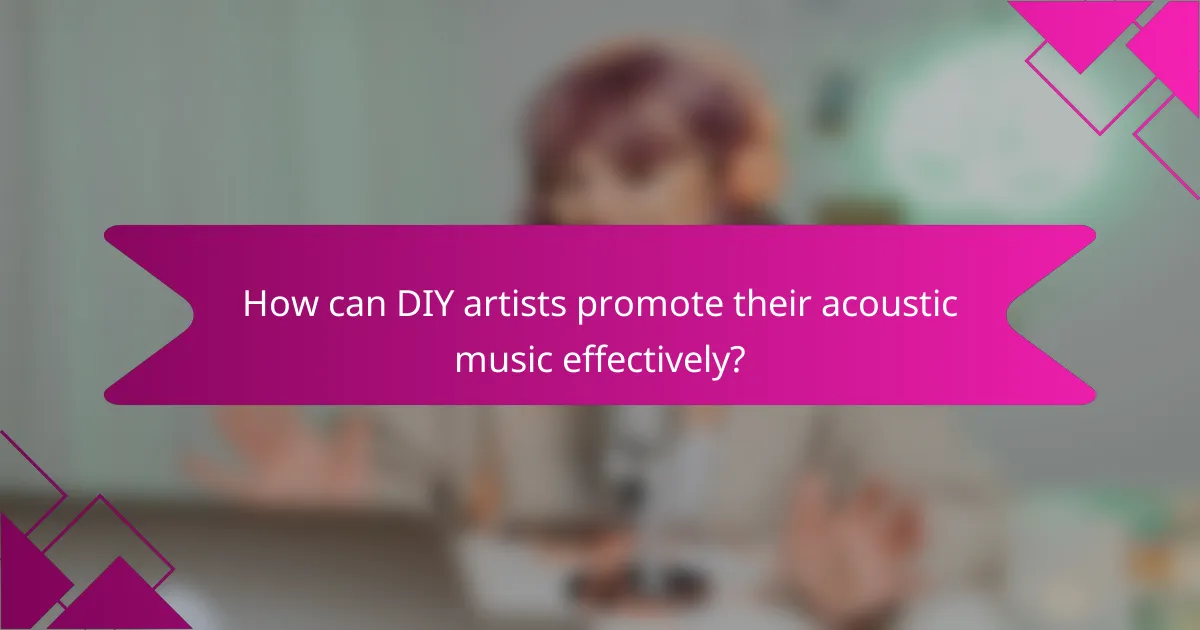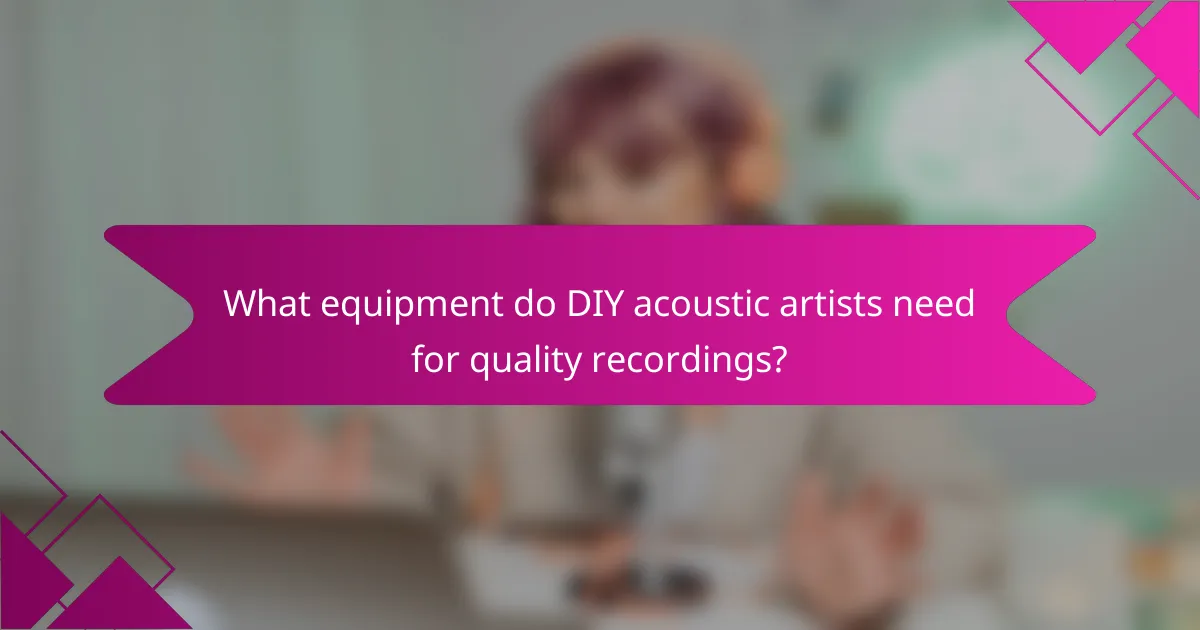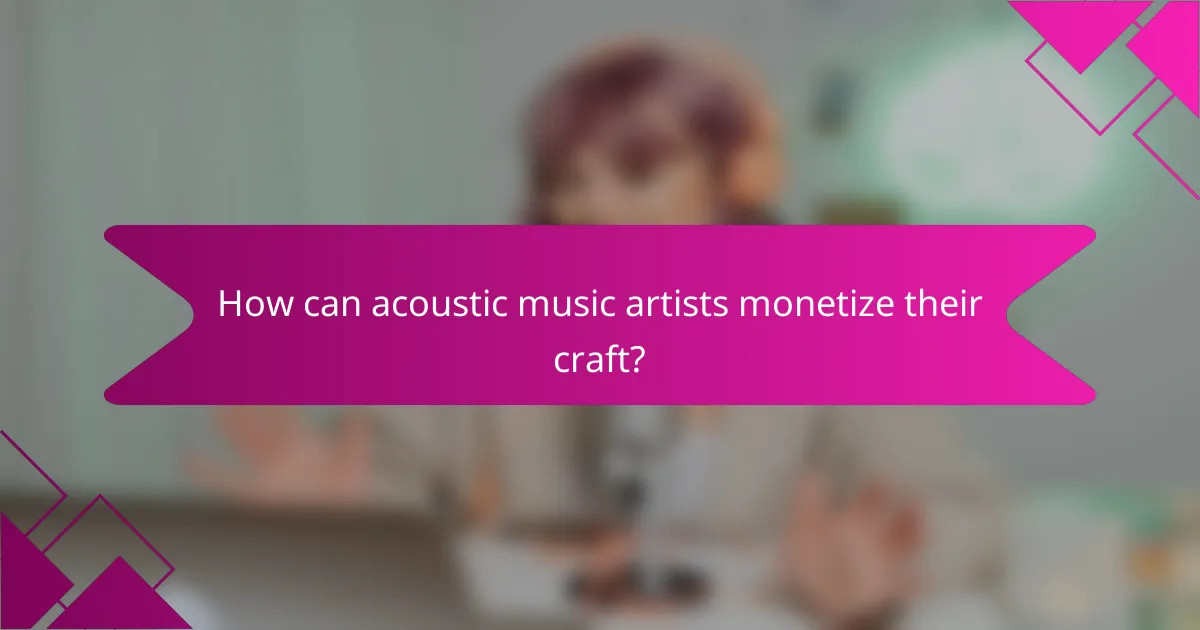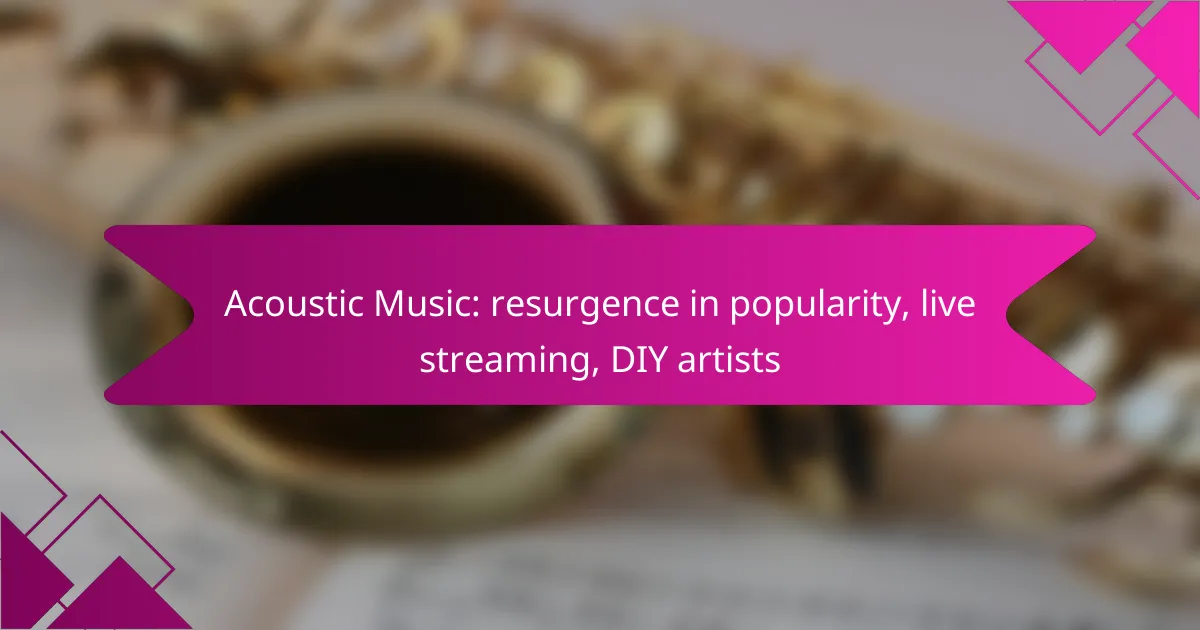Acoustic music is witnessing a resurgence in popularity, fueled by a renewed appreciation for its authenticity and simplicity. This revival is largely driven by the rise of live streaming platforms and the emergence of DIY artists, who are effectively engaging audiences and promoting their work in innovative ways.

How is acoustic music gaining popularity in the United States?
Acoustic music is experiencing a resurgence in the United States, driven by a growing appreciation for its authenticity and simplicity. This trend is fueled by various factors, including the rise of live streaming, DIY artists, and a renewed interest in folk and indie genres.
Rise of acoustic music festivals
Acoustic music festivals have become increasingly popular across the United States, attracting diverse audiences who appreciate the intimate atmosphere and the focus on live performances. Events like the Newport Folk Festival and MerleFest showcase both established and emerging acoustic artists, providing a platform for creativity and community engagement.
These festivals often feature a mix of genres, including folk, bluegrass, and singer-songwriter performances, creating a vibrant space for fans to connect with artists. Many festivals also incorporate workshops and jam sessions, encouraging participation and collaboration among attendees.
Influence of social media platforms
Social media platforms like Instagram, TikTok, and YouTube have significantly impacted the popularity of acoustic music by allowing artists to share their work directly with audiences. Musicians can easily showcase their talents through short videos or live streams, reaching potential fans without the need for traditional marketing channels.
This accessibility has led to the emergence of viral acoustic covers and original compositions, helping artists gain recognition and build dedicated followings. Additionally, social media fosters a sense of community among fans, encouraging them to engage with artists and each other.
Increased interest in folk and indie genres
The revival of acoustic music aligns with a broader trend of increased interest in folk and indie genres, which emphasize storytelling and emotional connection. Many listeners are drawn to the raw, unfiltered sound of acoustic instruments, finding it a refreshing alternative to heavily produced music.
Streaming services have made it easier for fans to discover new acoustic artists and explore niche genres. Playlists featuring folk and indie tracks often highlight emerging talent, further fueling the demand for acoustic music and encouraging artists to experiment with their sound.

What are the best platforms for live streaming acoustic performances?
The best platforms for live streaming acoustic performances include Twitch, Facebook Live, and YouTube Live. Each platform offers unique features that cater to different audience engagement and reach, making them suitable for various types of artists.
Twitch for musicians
Twitch is primarily known for gaming, but it has become a vibrant space for musicians to connect with fans through live performances. Artists can create a dedicated channel, interact with viewers via chat, and even earn revenue through subscriptions and donations.
To maximize your presence on Twitch, stream regularly and engage with your audience during performances. Use high-quality audio equipment to ensure your music sounds great, as sound quality is crucial for acoustic performances.
Facebook Live for audience engagement
Facebook Live allows musicians to reach their existing followers and engage with them in real-time. This platform is particularly effective for building community, as viewers can comment and react during the performance, creating an interactive experience.
To leverage Facebook Live, promote your upcoming streams in advance and consider scheduling them at times when your audience is most active. Use Facebook’s tools to create events and reminders to keep your fans informed.
YouTube Live for broader reach
YouTube Live offers musicians the opportunity to reach a global audience, as it is one of the largest video platforms. Live streams can be archived for later viewing, allowing new fans to discover your performances even after the event has ended.
When using YouTube Live, focus on optimizing your video quality and engaging with viewers through the live chat feature. Promote your stream across your social media channels to attract a larger audience and consider collaborating with other artists to expand your reach.

How can DIY artists promote their acoustic music effectively?
DIY artists can promote their acoustic music effectively by leveraging online platforms, engaging with their audience, and building local connections. A strategic approach that combines digital sales, social media presence, and collaborations can significantly enhance visibility and sales.
Utilizing Bandcamp for sales
Bandcamp is a powerful platform for DIY artists to sell their acoustic music directly to fans. Artists can set their own prices, offer digital downloads, and even sell physical merchandise, creating a personalized shopping experience. Consider offering exclusive content or limited-time discounts to encourage purchases.
Additionally, Bandcamp allows artists to share their stories and connect with listeners through artist profiles. This personal touch can foster a loyal fan base and increase sales over time.
Creating engaging content on Instagram
Instagram is an essential tool for DIY artists to showcase their acoustic music and connect with fans. Regularly posting high-quality videos of live performances, behind-the-scenes content, or songwriting processes can engage followers and attract new listeners. Use relevant hashtags to increase visibility and reach a broader audience.
Consider hosting Instagram Live sessions to perform songs or interact with fans in real-time. This not only builds community but also provides an opportunity to promote upcoming releases or events.
Collaborating with local venues
Collaborating with local venues can provide DIY artists with valuable exposure and performance opportunities. Reach out to small cafes, bars, or community centers that host live music events and propose to perform. Many venues are open to featuring local talent, especially if they can draw in a crowd.
Additionally, consider organizing joint events with other local artists to share audiences and resources. This can enhance the overall experience for attendees and increase the chances of repeat performances at those venues.

What equipment do DIY acoustic artists need for quality recordings?
DIY acoustic artists need essential equipment like microphones, audio interfaces, and digital audio workstations to achieve quality recordings. Investing in the right tools can significantly enhance sound quality and production value.
Microphones for acoustic instruments
Choosing the right microphone is crucial for capturing the nuances of acoustic instruments. Condenser microphones are often preferred for their sensitivity and clarity, making them ideal for vocals and string instruments. Popular models include the Audio-Technica AT2020 and the Rode NT1, which are both budget-friendly and effective.
When setting up, consider the microphone placement as it can greatly affect the sound. A distance of about 6 to 12 inches from the instrument typically yields a balanced tone. Experimenting with angles and positions can help find the best sound for each unique instrument.
Audio interfaces for home studios
An audio interface is essential for connecting microphones and instruments to a computer, converting analog signals to digital. Look for interfaces with at least two inputs and good preamps to ensure high-quality recordings. Models like the Focusrite Scarlett 2i2 and PreSonus AudioBox USB are popular choices among DIY artists.
When selecting an audio interface, consider the compatibility with your computer’s operating system and the software you plan to use. USB interfaces are common and generally easy to set up, making them a good option for beginners.
Digital audio workstations like Ableton Live
A digital audio workstation (DAW) is software that allows you to record, edit, and produce music. Ableton Live is a favored choice for many DIY acoustic artists due to its user-friendly interface and powerful features. It offers a range of tools for recording live performances and layering tracks.
When using a DAW, familiarize yourself with its basic functions such as track creation, mixing, and effects application. Many DAWs offer free trials, so take advantage of these to find the one that best suits your workflow and creative style.

What are the key considerations for acoustic music production?
Key considerations for acoustic music production include selecting an appropriate recording space, mastering mixing techniques, and ensuring compatibility with streaming platforms. Each aspect significantly influences the final sound quality and listener experience.
Choosing the right recording space
Selecting the right recording space is crucial for capturing the natural sound of acoustic instruments. Look for a room with good acoustics, which typically means minimal echo and background noise. Spaces with soft furnishings or acoustic panels can help absorb sound reflections.
Consider the size of the room as well; larger spaces can provide a richer sound but may require more careful mic placement to avoid unwanted reverberation. If possible, test different locations to find the one that best suits your style and instruments.
Understanding mixing techniques
Mixing techniques play a vital role in shaping the final sound of your acoustic music. Start by balancing the levels of each instrument to ensure clarity and presence. Use panning to create a sense of space, placing instruments in different positions across the stereo field.
Experiment with EQ to enhance or reduce certain frequencies, which can help each instrument stand out. Be cautious not to over-compress your tracks, as this can strip away the dynamic range that is often a hallmark of acoustic music.
Mastering for streaming platforms
Mastering for streaming platforms requires attention to specific loudness standards, which vary by service. Aim for a loudness level around -14 LUFS for most platforms to ensure your music sounds good across different playback systems.
Additionally, consider the file format and quality; high-resolution files are preferred, but ensure they are converted to the appropriate format (such as WAV or MP3) for streaming. Always test your mastered tracks on various devices to confirm they translate well in different listening environments.

How can acoustic music artists monetize their craft?
Acoustic music artists can monetize their craft through various channels, including merchandise sales and exclusive content offerings. By leveraging online platforms, they can reach wider audiences and create sustainable income streams.
Merchandise sales through online stores
Merchandise sales are a direct way for acoustic artists to earn money. They can sell items like T-shirts, vinyl records, and other branded products through platforms such as Bandcamp, Etsy, or their own websites. Pricing should reflect production costs while remaining affordable for fans, typically ranging from $15 to $40 per item.
To maximize sales, artists should promote their merchandise during live streams and social media interactions. Offering limited-edition items can create urgency and encourage fans to purchase quickly. Additionally, bundling merchandise with music downloads can enhance value for fans.
Offering exclusive content on Patreon
Patreon allows artists to offer exclusive content to fans in exchange for a monthly subscription fee. This can include behind-the-scenes videos, early access to new music, or private live streams. Subscription tiers can range from $5 to $50, depending on the level of access and content provided.
Artists should clearly communicate the benefits of subscribing, such as unique insights into their creative process or personal interactions. Regularly updating content and engaging with patrons can help maintain and grow the subscriber base, ensuring a steady income stream.
